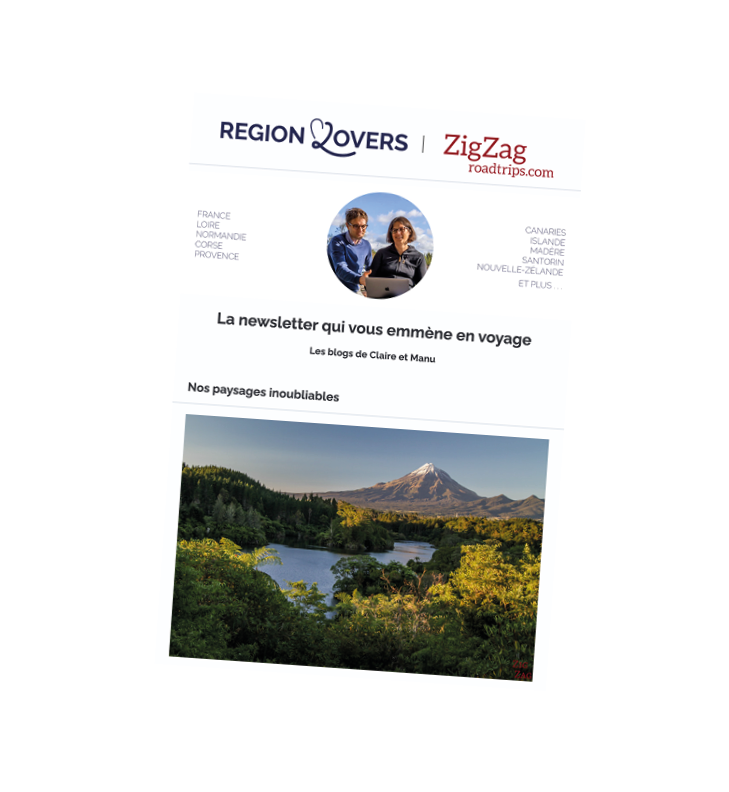When is the best time to visit Corsica? When to go?
Well, that depends on your criteria.
Here’s our complete guide with details to help you make your decision based on:
- The weather in Corsica (temperature, rain, water…),
- Sea temperature, when to swim in Corsica,
- The crowd,
- Pricing,
- Conditions for hiking and other activities,
- …
BEFORE OUR TIPS + PHOTOS
HERE ARE OUR FAVORITES IN Corsica

Our favorite car rental platform: DiscoverCars

Our guide to planning your road trip: eBook

Our must-do boat trip: Exploring the cliffs of Bonifacio

Our favorite towns to stay in:
- Bonifacio near the citadel – see the best rated accommodations
- Porto-Vecchio near the beaches – see top-rated accommodations
- L’Île-Rousse in Balagne – see the best-rated accommodations
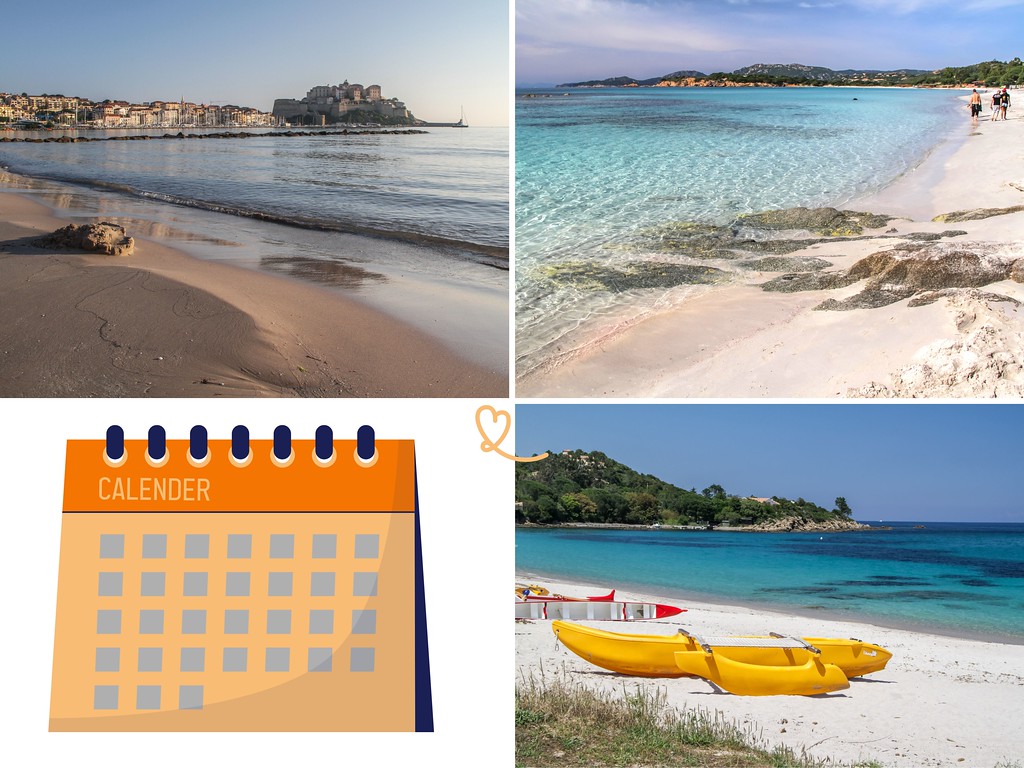
This guide is completely independent, based on our experiences. We visited the area anonymously, making our own choices and paying all our bills in full.
Best time to visit Corsica – Summary
Best month to visit Corsica
May, June, September and October are the best times to discover Corsica: the weather is sunny, the locals are in better spirits (less crowds, less stress) and the places are not crowded.
However, in May, the sea water is much cooler than in summer.

When to visit Corsica – criteria
If you don’t want to read the whole article, here’s a summary depending on what you’re looking for:
- Weather, Rain –
The driest months are June, July, August and September.
The wettest months are November, January, February and March. - Weather, temperatures –
Summer temperatures average 28°C at sea level, and are equally hot in the mountains.
In May and October, the average temperature is 23°C. - Swimming –
The best time to swim in the sea is from July to September, with an average temperature of 27°C.
But it’s just as pleasant to swim in June and October, with water temperatures between 23 and 24°C.

- Crowd –
July and August are the busiest months for visitors - Opening
Many hotels and restaurants only open for the season, starting in April and closing at the end of October. - Price –
Prices are of course higher when the island is busiest – in summer. - Hiking –
May, June, September and October – ideal temperatures for hiking

Visual overview – When to go to Corsica
Here’s an infographic to help you visualize the best periods and decide the best time to go to Corsica according to your criteria.
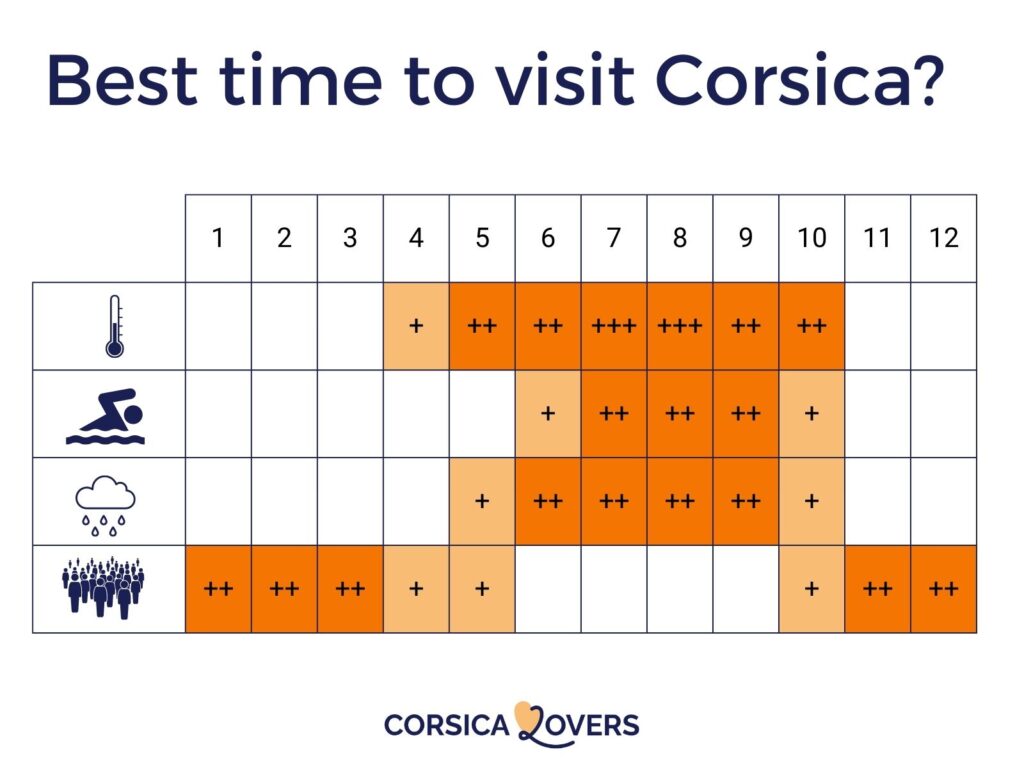
OUR TIPS FOR RENTING A CAR IN Corsica
- Compare prices on our preferred platform: DiscoverCars – one of the best rated sites.
- Choose a car that is powerful enough (the roads are steep) but compact (some passages are narrow).
- Think of thecomplete insurance (some roads are tortuous and narrow).
- There is a lot of demand, book it early.
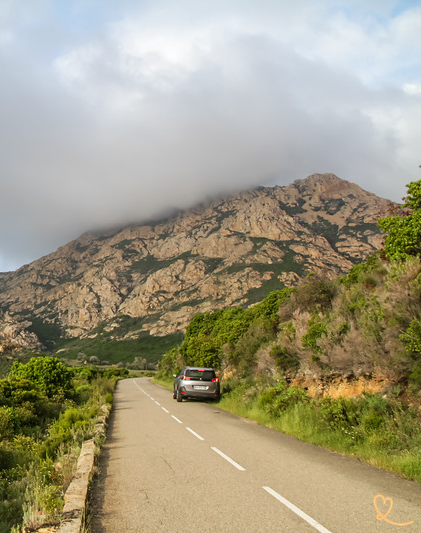
When to go to Corsica – Conditions
When is the best time to visit Corsica and take advantage of the exceptional weather?
Climate
Corsica’s climate is Mediterranean, characterized by hot, dry summers and mild, rainy winters. Average temperatures generally range from 11°C in winter to 27°C in summer.
However, it is important to note that there can be significant variations between regions, mainly depending on altitude and proximity to the sea.
In Corsica, you’re also exposed to strong winds, such as the famous mistral. Beware, they can blow very violently in winter.

North or South?
If you’re wondering whether you should go north (Haute-Corse department) or south (Corse-du-Sud department), to be honest the differences aren’t huge. The biggest differences are between the mountains and the seaside, and both regions have these reliefs.
Length of day and sunshine
Quite classic for Europe… The average length of day is:
- 9:30 am, the shortest day of the year, December 21
- 2:30 pm, the longest day, June 21.
In terms of sunshine, Corsica enjoys plenty of it, especially in summer. Corsica has an average of 300 sunny days a year.
So you can enjoy plenty of sunshine, whether you go there in summer or even winter.

Rain in Corsica
We can’t guarantee how much rain you’ll get. It depends on the region and the time of year, and even the year. Sometimes the month of May can be magnificent, and other years more gray.
It also depends on when you go out during the day. Corsica has quite a few thunderstorms at the end of the day, so if you start your activities in the early afternoon you’re likely to complain about the weather.
Corsica receives an average of 1,000 to 1,500 millimeters of water per year, but rainfall varies from region to region.
The coastal regions are drier than the mountainous inland areas. Balagne, for example, is one of the driest regions in Corsica.
The rainiest period is generally between November and February.

USE OUR GUIDE TO PLAN A
DREAM TRIP TO Corsica
All the information you need for your trip:
- 7 maps that make planning easier
- 130+ pre-selected locations
- Practical advice
- + 220 photos to help you choose
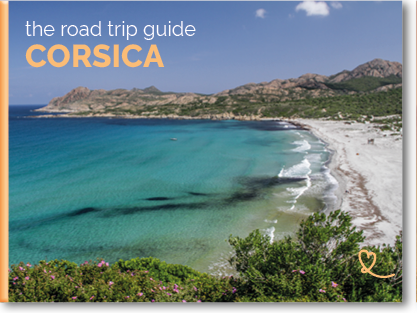
Crowds
Corsica attracts a large number of visitors during the school vacation periods, especially in summer. Crowds are mainly concentrated in the most popular tourist areas, such as Ajaccio, Bastia, Porto-Vecchio, Calvi and Bonifacio. Corsica’s beaches, especially those in the south, are extremely popular during this period.
However, if you go a little further inland you can find some more peaceful and less crowded spots.
As Corsica is a very popular destination, we recommend planning and booking in advance, especially if you plan to travel during the peak tourist season.

Sea temperatures in Corsica – when to swim
Sea temperatures in Corsica vary quite a lot between winter and summer.
- In spring, allow for 15 to 18°C
- In summer, 21 to 25°C
- In autumn, 19 to 22°C
- In winter, 13 to 15°C
May offers beautiful temperatures for exploring, but some will find the water quite cold.
If, above all, you want to enjoy Corsica’s most beautiful beaches the main months for swimming and lounging on the beach are between June and September.

Subscribe to our Newsletter
- Get away from it all with Region Lovers’ beautiful destinations!
- Once a month
- Advertising-free
Best time to go to Corsica – other criteria
When to hike in Corsica

Hiking is undoubtedly one of the most popular activities in Corsica. However, it’s best to avoid the peak tourist season, even if conditions are ideal.
If you’re traveling during the summer, choose less famous hikes, or start very early to avoid meeting too many people.
But for a more pleasant experience (especially along the famous GR20 hiking trail), choose spring or autumn.
Don’t be disappointed by the waterfalls

The best time to admire the waterfalls is late spring. The snows are melting and the waterfalls are at their peak.
Don’t be disappointed if you go to see them in late summer and only a trickle of water flows!
Price
The highest prices for ferries, planes, cars and hotels are in July and August.
The lowest prices are often in November and January.
PLAN YOUR TRIP TO Corsica
Inspiration destinations

Best of
- The most beautiful beaches of Corsica
- The most beautiful villages of Corsica
- The most beautiful cities of Corsica
- The most beautiful destinations in Corsica
- The museums of Corsica
- Hidden gems in Corsica
- The most beautiful natural pools
- What to do in North Corsica
- Best things to do in South Corsica
- Canyoning in Corsica
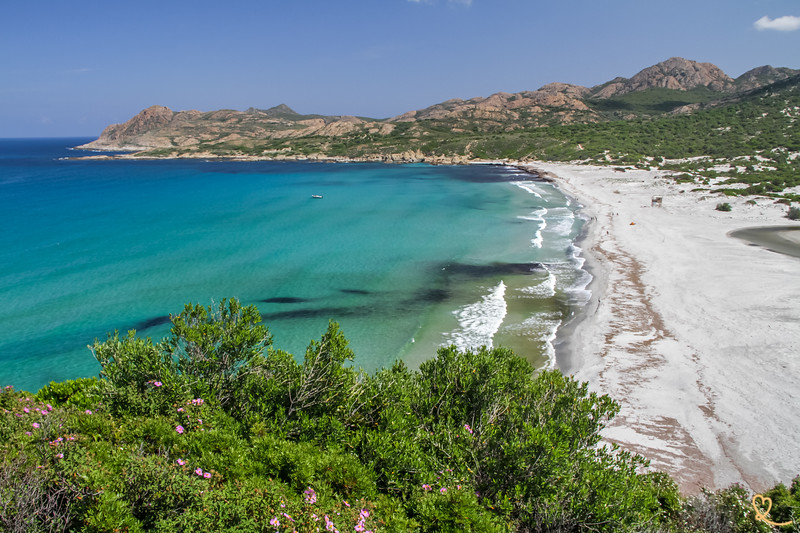
Where to stay

Description of the seasons in Corsica
Spring in Corsica
Spring marks the return of the sun, temperatures rise rapidly and the snow on the peaks melts. From March to May, rainfall is scarce, especially along the coast.
In April you can expect an average of 15°C, and in May this rises to around 18°C, with daytime peaks above 20°C.
The sea is beginning to warm up but is still quite cool.

Summer in Corsica
Summers in Corsica are hot and dry (Mediterranean climate). Temperatures rise rapidly and rain is practically non-existent (especially in the form of heat storms).
You can expect temperatures averaging between 24 and 26°C by the sea, with daytime highs above 30°C.
August is the hottest and driest month. This is the ideal time to enjoy seaside holidays and the pleasures of the beach and sea.

Autumn in Corsica
In autumn, the sun is still shining and temperatures remain mild for a long time. And the sea takes its time to cool off.
It’s a great season for exploring and swimming.
But by the end of October, the cooler weather returns and we feel winter approaching.

Winter in Corsica
Winter in Corsica is generally mild, although rainfall is relatively abundant, especially in mountainous regions.
From December to March, the average temperature is around 10 to 11°C by the sea.
January is the coldest and rainiest month.
Find out more in our article on Corsica in winter.

Events to see or avoid
Depending on your interests, you should also take into account events that could have a major impact on your trip, and adapt your departure dates accordingly:
- If you really want to see a party
- If you don’t want to be blocked by an event
Festivals in Corsica (music and culture)
- March-April in Calvi
The Passion of the Christ, a series of events in the city during Holy Week, including processions. - June 2, in Ajaccio, Bastia and Calvi
Feast of Saint Erasmus, patron saint of sailors and fishermen. The fishermen’s boats are blessed. And you can taste freshly caught fish. - June
2 jazz festivals: Calvi Jazz Festival and Jazz in Aiacciu with a host of concerts - July in Calvi
Calvi on the Rocks is a major musical event featuring rock and electronic music. - July – just about everywhere
There are also several small music festivals in the villages: Pigna (Festivoce), Erbalunga… - August in Ajaccio
Napoleonic Days with exhibitions, workshops and shows - September in Calvi
Les Rencontres Polyphoniques de Calvi with a host of traditional song performances. - November in Bastia
Les Musicales de Bastia, another music festival.

Sports competitions in Corsica
- April in Ajaccio
Ajaccio Marathon - June in Corte
Cavall’in Festa, horse fair in Corte - July – maybe
Check out the route of the Tour de France (cycling competition). Some years they pass through Corsica, and that can really cut up the roads! - October in Porto-Vecchio
Porto-Vecchio Marathon - October
Tour de Corse (motor racing)
OUR TIPS FOR RENTING A CAR IN Corsica
- Compare prices on our preferred platform: DiscoverCars – one of the best rated sites.
- Choose a car that is powerful enough (the roads are steep) but compact (some passages are narrow).
- Think of thecomplete insurance (some roads are tortuous and narrow).
- There is a lot of demand, book it early.

Best month to go to Corsica
Corsica in January
In January, the climate in Corsica is cool. The north of the island can be subject to strong, cold winds, and the west coast is rainy. Also beware of rain and storms in the mountains. The temperatures during the day allow you to go for a walk. Skiing and surfing enthusiasts will also find their happiness if the weather conditions allow it. Nevertheless, this is not the best time to visit Corsica.
See our article: Going to Corsica in January.
Corsica in February
In February, the climate in Corsica is cool. The north of the island can be subject to strong, cold winds, and the west coast is rainy. Also beware of rain and storms in the mountains. The temperatures during the day allow you to go for a walk. Skiing and surfing enthusiasts will also find their happiness if the weather conditions allow it. Nevertheless, this is not the best time to visit Corsica.
See our article: Going to Corsica in February.

Corsica in March
In March, the climate in Corsica is mild. The north of the island is subject to sometimes strong winds, and the west coast is still rainy. On the other hand, the daytime temperatures are very mild, allowing pleasant walks. Skiing enthusiasts will find their happiness, as will surfing fans if the weather conditions allow it. Nevertheless, this is not the best time to visit Corsica.
See our article: Going to Corsica in March.
Corsica in April
Corsica enjoys relatively good weather in April. The north of the island is subject to sometimes strong winds, and rains are a little more frequent on the west coast. On the other hand, the temperatures are very mild and the summer heat has not yet arrived: ideal for hiking. It is a good time to visit Corsica.
See our article: Going to Corsica in April.
Corsica in May
The weather is fine in Corsica in May. The days are long and the rains are light, although a little more frequent on the west coast. Temperatures are warm and the sky is generally clear. The climate is perfect for hiking before the summer heat. It is also the swimming season. It is the ideal period to visit Corsica.
See our article: Going to Corsica in May.

Corsica in June
In fact, in June, the weather is warm and sunny without being too hot. This is one of the best months to visit the island, with smaller crowds of tourists!
The north and south offer similar conditions. The whole island can be visited.
See our article: Going to Corsica in June.
Corsica in July
The weather is very nice in Corsica in July. The days are very long, the rains rare and the wind warm and pleasant. The sky is clear and the sun is shining. The temperatures are very hot, sometimes too hot, and the holidaymakers are very numerous. July is a very good time to visit Corsica.
See our article: Going to Corsica in July.
Corsica in August
The weather is very nice in Corsica in August. The days are very long, the rains rare and the wind warm and pleasant. The sky is clear and the sun is shining. The temperatures are very hot. On the other hand, it is sometimes too hot, there can be big thunderstorms and there are a lot of holidaymakers. August remains a good period to visit Corsica.
See our article: Going to Corsica in August.
Corsica in September
The weather in Corsica is very fine in September. The few rains are fine and the wind is warm and pleasant. The sky is clear and the sun is shining. It is hot, but not too hot: the climate is perfect for swimming and hiking. However, beware of storms.
See our article: Going to Corsica in September.

Corsica in October
The weather is relatively good in Corsica in October. The temperatures are warm. The sky is clear and sunny, especially on the east coast, towards Bastia and Porto-Vecchio. Rains are more frequent on the west coast. It is still the season for swimming and hiking. The autumn winds are blowing again, for the happiness of the surfers. However, beware of thunderstorms, which are more frequent during this period.
See our article: Going to Corsica in October.
Corsica in November
In November, Corsica is rainy and storms are more frequent. The north of the island is subject to cold and powerful winds. Temperatures are mild, but it is not the best time to visit Corsica.
See our article: Going to Corsica in November.
Corsica in December
In December, the climate in Corsica is mild. The north and west of the island are subject to cold and powerful winds. Rains are more frequent on the west coast. The temperatures allow pleasant walks. Skiing and surfing enthusiasts will also find their happiness, if the weather conditions allow it. Nevertheless, this is not the best time to visit Corsica.
See our article: Going to Corsica in December.


